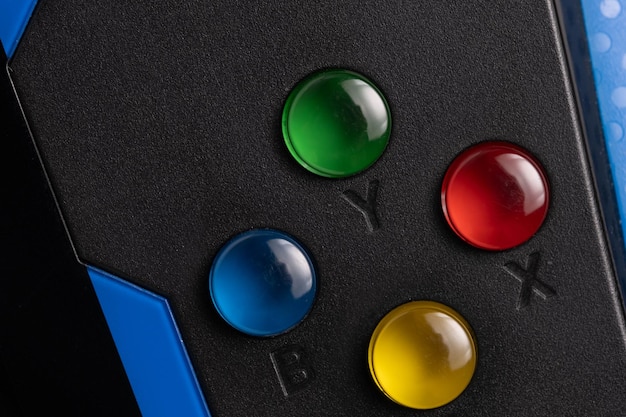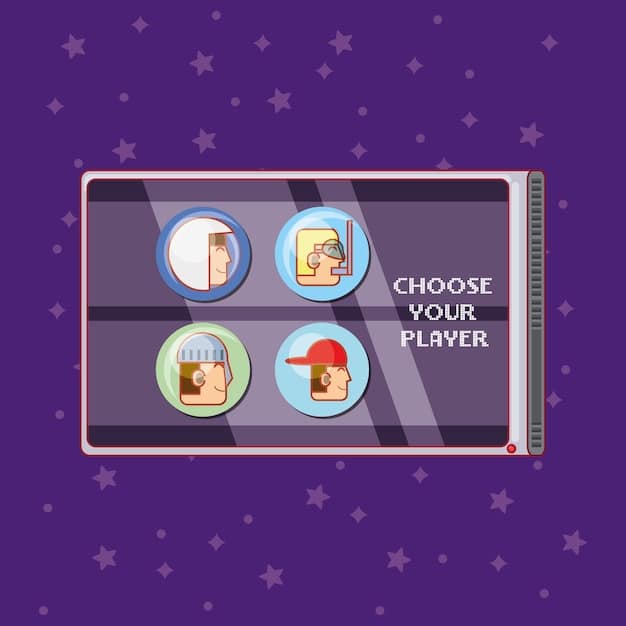Accessibility in Gaming: Games That Prioritize Inclusivity

Accessibility in gaming is crucial for inclusivity, ensuring that players with disabilities can enjoy and participate in the gaming experience, as highlighted by several games that have successfully implemented and prioritized these features.
Gaming is a universal language, but sometimes the dialogue is lost in translation for those who experience the world differently. Today, we delve into the importance of accessibility in gaming: a review of games that prioritize inclusivity, ensuring everyone can join the adventure.
Why Accessibility Matters in Gaming
Accessibility in gaming isn’t just a feature; it’s a gateway to inclusion. It allows players with disabilities to fully participate in the gaming world, fostering a sense of community and belonging.
By understanding the needs of all players, developers can create experiences that are enjoyable and engaging for everyone.
Breaking Down Barriers
Many barriers can prevent gamers with disabilities from fully enjoying video games. These can include challenges related to vision, hearing, mobility, and cognitive function.
- Visual Impairments: Gamers with low vision or blindness often struggle with games that rely heavily on visual cues. Text-to-speech options and customizable interfaces can help.
- Auditory Impairments: Games with essential audio cues may be difficult for players who are deaf or hard of hearing. Visual cues and subtitles are crucial.
- Mobility Issues: Traditional controllers can be challenging for players with limited hand or arm movement. Customizable controls and adaptive controllers can make a significant difference.
- Cognitive Differences: Complex game mechanics or overwhelming interfaces can hinder players with cognitive disabilities. Simplified controls and clear tutorials can improve accessibility.

Ultimately, accessibility is about ensuring that everyone has the opportunity to experience the joy and benefits of gaming. It’s about creating a more inclusive and welcoming community for all.
Key Accessibility Features in Modern Games
Modern games are increasingly incorporating a range of accessibility features. These features are designed to address the diverse needs of gamers with disabilities, making games more enjoyable and inclusive.
Let’s explore some of the key accessibility features that are making a difference.
Customizable Controls
The ability to remap buttons and customize control schemes is a game-changer for many players. It allows gamers to tailor the controls to their specific needs and preferences.
This is essential for those who use alternative input methods or have limited mobility.
Text-to-Speech and Speech-to-Text
Text-to-speech (TTS) and speech-to-text (STT) features can significantly enhance accessibility for players with visual or auditory impairments. TTS reads on-screen text aloud, while STT converts spoken words into text.
This enables easier communication and navigation within the game.
Subtitle Options
Subtitles are a standard accessibility feature, but their quality and customization options can vary widely. Good subtitles should be clear, easy to read, and customizable in terms of size, color, and background.
They should also include speaker identification and sound effect descriptions.
- Adjustable font size and color
- Speaker identification
- Sound effect captions
- Customizable background
These features collectively enhance the gaming experience, ensuring it is more inclusive and enjoyable for players of all abilities. By prioritizing accessibility, game developers not only improve the gaming experience for individuals with disabilities but also enrich the gaming community as a whole.
Games Leading the Way in Accessibility
Several games have set a high standard for accessibility, demonstrating a commitment to inclusivity and providing enjoyable experiences for all players.
These games serve as examples of what can be achieved when accessibility is prioritized during development.

The Last of Us Part II
Naughty Dog’s “The Last of Us Part II” is widely praised for its extensive suite of accessibility features. The game includes options for vision, hearing, and motor accessibility, as well as customizable difficulty settings.
It offers features such as text-to-speech, high contrast mode, and customizable controls.
Forza Motorsport
“Forza Motorsport” has been noted for its inclusive implementation of features catering to a variety of disabilities. Microsoft has updated the game with text-to-speech functionality, customized controls, and more.
The updated features allow more gamers to enjoy what the game has to offer.
Grounded
This survival adventure game from Obsidian Entertainment includes features like customizable subtitles, text scaling, and control remapping to ensure players of all abilities can explore its backyard world.
The game’s dedication to inclusivity shows how smaller studios can also prioritize accessibility.
These titles demonstrate that accessibility is not just a checkbox item but a core design principle. By prioritizing inclusivity, developers create experiences that resonate with a broader audience and foster a more welcoming gaming community.
Challenges and Future Directions
While significant progress has been made, challenges remain in making gaming truly accessible. Overcoming these challenges will require ongoing collaboration and innovation.
Let’s examine some of the current obstacles and future directions.
Awareness and Education
Many developers may not be fully aware of the accessibility needs of gamers with disabilities. Increased awareness and education are essential to fostering a culture of inclusivity.
Workshops, conferences, and online resources can help developers learn about accessibility best practices.
Cost and Resources
Implementing accessibility features can require additional resources and expertise. Small and independent developers may struggle to afford these investments.
Government grants, industry partnerships, and open-source tools can help alleviate the financial burden.
Standardization
The lack of standardized accessibility guidelines can make it difficult for developers to know where to start. Establishing industry-wide standards would provide a clear roadmap for creating accessible games.
- Industry-wide accessibility guidelines
- Certification programs for accessible games
- Accessibility testing and feedback
By addressing these challenges and embracing new technologies, the gaming industry can create a future where everyone can participate and enjoy the benefits of gaming.
The Business Case for Accessibility
Beyond the ethical considerations, there is a strong business case for prioritizing accessibility in gaming. Inclusive games can reach a larger audience and generate more revenue.
Accessibility is not just the right thing to do; it’s also a smart business decision.
Expanding the Market
Gamers with disabilities represent a significant and often overlooked market segment. By making games accessible, developers can tap into this market and increase their sales.
Inclusive games can also attract players who appreciate and support accessible design.
Enhancing Brand Reputation
Companies that prioritize accessibility are viewed more favorably by consumers. A commitment to inclusivity can enhance a brand’s reputation and build customer loyalty.
Positive word-of-mouth and media coverage can further boost a company’s image.
Driving Innovation
Designing games for accessibility can lead to innovative and creative solutions that benefit all players. Features like customizable controls and alternative input methods can enhance the gaming experience for everyone.
The same features designed for accessibility can be used for other disabilities.
In conclusion, the business case for accessibility is clear. By embracing inclusivity, developers can expand their market, enhance their brand reputation, and drive innovation. It’s a win-win situation for both the gaming industry and the gaming community.
How to Advocate for Accessibility in Gaming
Individual gamers can play a crucial role in advocating for accessibility in gaming. By raising awareness and demanding change, players can help create a more inclusive industry.
Here are some ways to advocate for accessibility:
Contact Developers
Reach out to game developers and publishers to request accessibility features. Provide specific feedback on how they can improve their games.
Many developers are receptive to feedback and willing to make changes.
Support Accessible Games
Support games that prioritize accessibility by buying them and recommending them to others. Positive sales and reviews can incentivize developers to continue investing in accessibility.
Share your experiences with accessible games on social media and online forums.
Join Advocacy Groups
Get involved with advocacy groups that focus on accessibility in gaming. These groups can provide resources, support, and a platform for collective action.
- Disability Rights Organizations
- Online Forums
- Social Media Groups
By working together, gamers can create a more inclusive and accessible gaming world. Every voice matters, and every action can make a difference.
| Key Point | Brief Description |
|---|---|
| 🎮 Importance of Accessibility | Ensures inclusivity for gamers with disabilities. |
| ⚙️ Key Features | Customizable controls, TTS, STT, subtitle options. |
| 🏆 Leading Games | “The Last of Us Part II,” “Forza Motorsport,” “Grounded.” |
| 📢 Advocacy | Contact developers, support inclusive games, join groups. |
[Frequently Asked Questions]
▼
Accessibility ensures that players with disabilities can enjoy the same gaming experiences as everyone else, promoting inclusivity and a sense of community.
▼
Common features include customizable controls, text-to-speech, speech-to-text, subtitle options, and adjustable difficulty settings to accommodate different needs.
▼
Games like “The Last of Us Part II”, “Forza Motorsport”, and “Grounded” are recognized for their extensive accessibility options, setting a high standard in the industry.
▼
Advocate by contacting developers, supporting accessible games, joining advocacy groups, and raising awareness about the importance of inclusivity in gaming.
▼
Accessibility features can benefit all players by providing more customizable and comfortable gaming experiences, making games more enjoyable for everyone, regardless of ability.
Conclusion
In conclusion, the importance of accessibility in gaming cannot be overstated. By prioritizing inclusivity, developers can create experiences that are enjoyable and accessible for all players. As technology continues to evolve, the possibilities for accessibility are endless, paving the way for a more welcoming and diverse gaming community.





